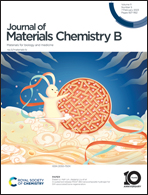Tumor-targeted molybdenum disulfide@barium titanate core–shell nanomedicine for dual photothermal and chemotherapy of triple-negative breast cancer cells†
Abstract
Combinational therapy can improve the effectiveness of cancer treatment by overcoming individual therapy shortcomings, leading to accelerated cancer cell apoptosis. Combinational cancer therapy is attained by a single nanosystem with multiple physicochemical properties providing an efficient synergistic therapy against cancer cells. Herein, we report a folate receptor-targeting dual-therapeutic (photothermal and chemotherapy) core–shell nanoparticle (CSNP) exhibiting a molybdenum disulfide core with a barium titanate shell (MoS2@BT) to improve therapeutic efficacy against triple-negative breast cancer (TNBC) MDA-MB-231 cells. A simple hydrothermal approach was used to achieve the MoS2@BT CSNPs, and their diameter was calculated to be approximately 180 ± 25 nm. In addition to improving the photothermal efficiency and stability of the MoS2@BT CSNPs, their surface was functionalized with polydopamine (PDA) and subsequently modified with folic acid (FA) to achieve enhanced tumour-targeting CSNPs, named MoS2@BT-PDA-FA (MBPF). Then, gemcitabine (Gem) was loaded into the MBPF, and its loading and releasing efficacy were calculated to be 17.5 wt% and 64.5 ± 3%, respectively. Moreover, the photothermal conversion efficiency (PCE) of MBPF was estimated to be 35.3%, and it also showed better biocompatibility, which was determined by an MTT assay. The MBPF significantly increased the ambient temperature to 56.3 °C and triggered Gem release inside the TNBC cells when exposed to a near-infrared (NIR) laser (808 nm, 1.5 W cm−2, 5 min). Notably, the MoS2@BT-based nanosystem was used as a photothermal agent and a therapeutic drug-loading container for combating TNBC cells. Benefiting from the combined therapy, MBPF reduced TNBC cell viability to 81.3% due to its efficient synergistic effects. Thus, the proposed tumour-targeting MoS2@BT CSNP exhibits high drug loading, better biocompatibility, and improved anticancer efficacy toward TNBC cells due to its dual therapeutic approach in a single system, which opens up a new approach for dual cancer therapy.

- This article is part of the themed collections: World Cancer Day 2024: Showcasing cancer research across the RSC, 2024 Journal of Materials Chemistry B Lunar New Year and 2023 Journal of Materials Chemistry B Most Popular Articles


 Please wait while we load your content...
Please wait while we load your content...